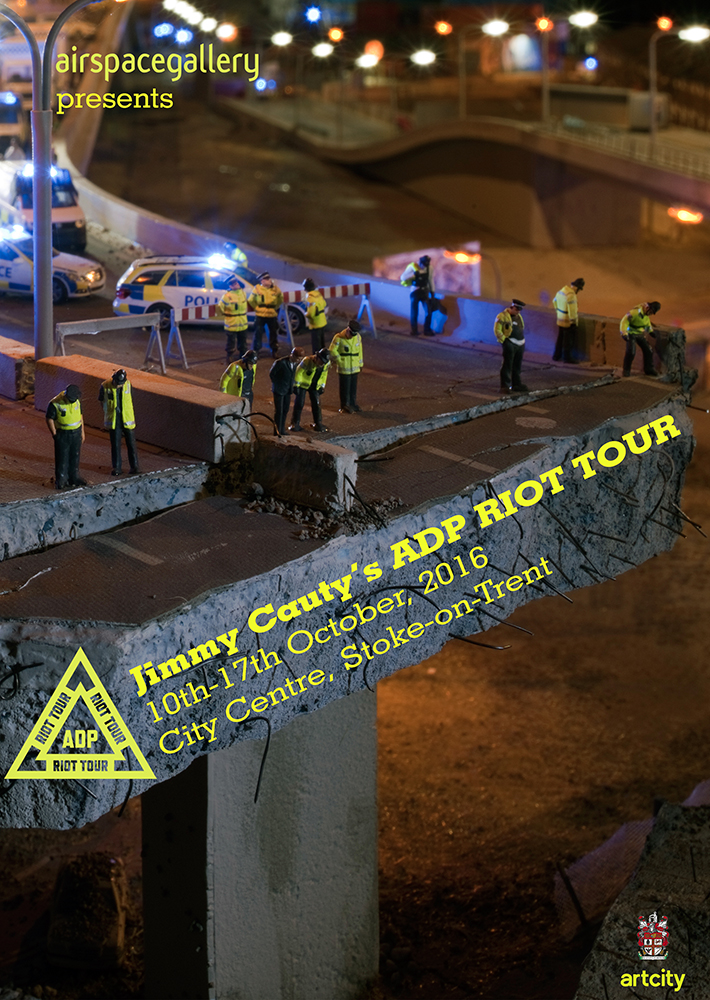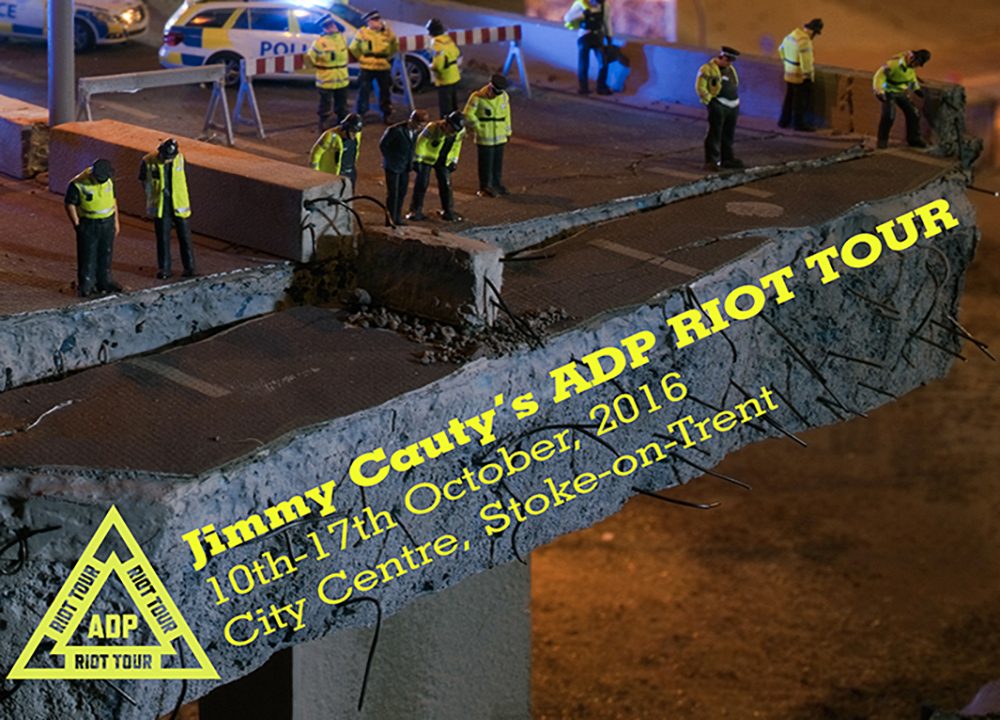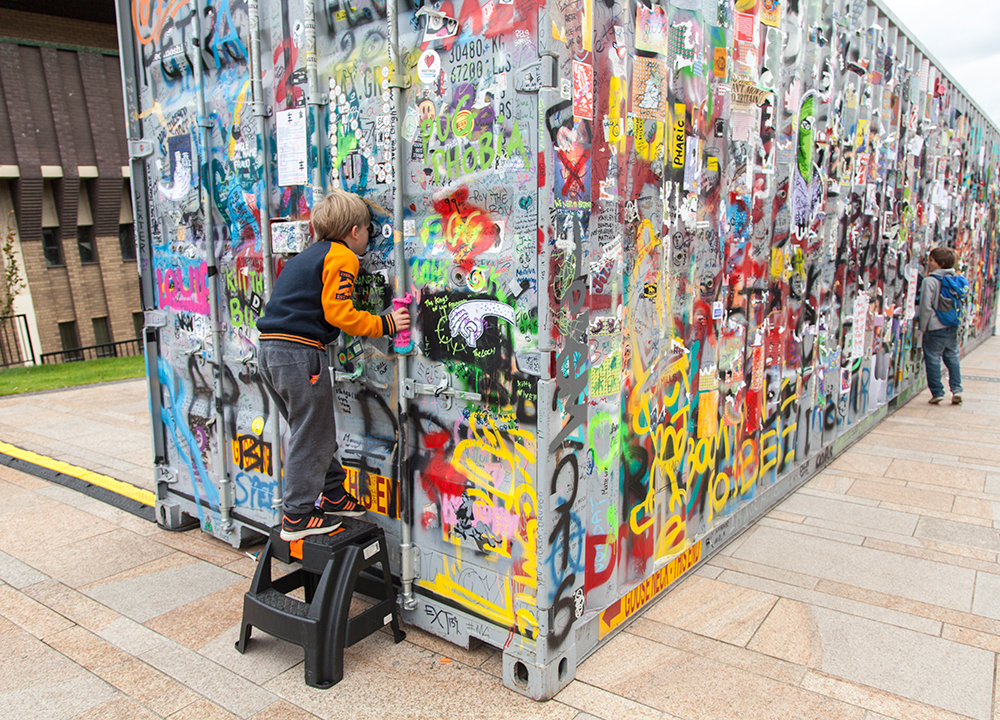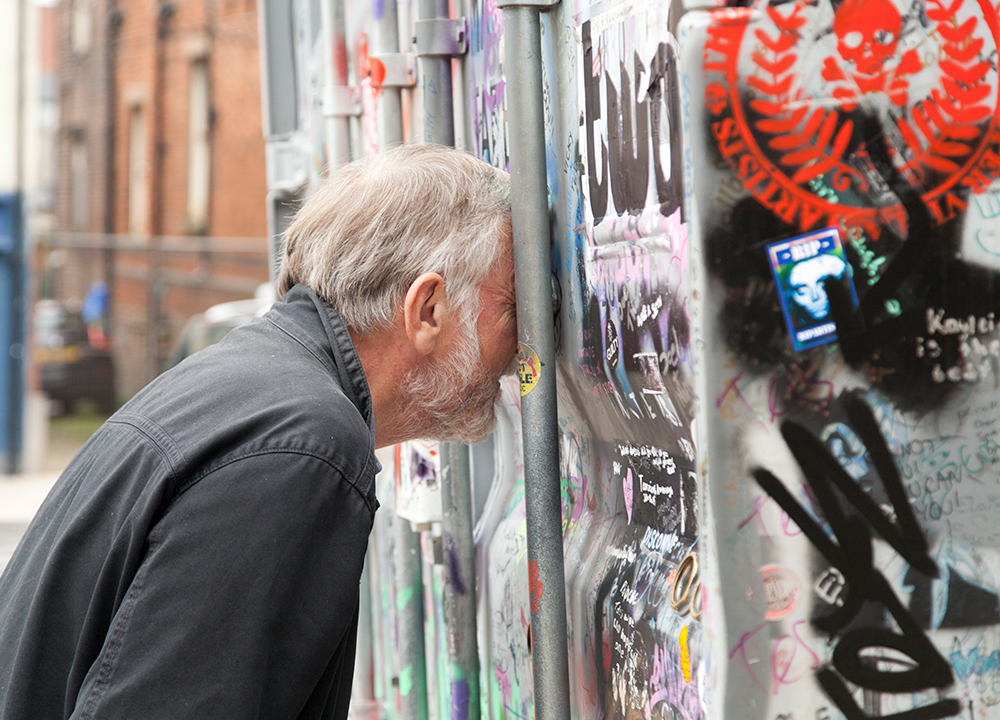ADP RIOT TOUR
JIMMY CAUTY
10 - 17 October, 2016Sited opposite the Gallery and animating for the first time, a brand new piece of Public Realm land, The Aftermath Dislocation Principle (ADP) is housed in a 40 ft shipping container, and depicts a monumental post-riot landscape in miniature. This dystopian model village is set somewhere in Bedfordshire, where only the police and media teams remain in an otherwise deserted, wrecked and dislocated land – all in 1:87 scale and viewed through peepholes in the side of the container.
Each location on the ADP tour responds to the installation through a reflection of a historic riot witnessed there. In Stoke-on-Trent, the 1842 Pottery Riots took place in the midst of the 1842 General Strike, and are credited with helping to forge trade unionism and direct action as a powerful tool in British industrial relations. The strike cause was championed by Chartists, who called for a General Strike across the Potteries and, by the end of July, strikes were endemic across North Staffordshire and beyond its county borders. Read Historian Fred Hughes' account of the riots below.
The origins of this piece lie in a series of works known as A Riot in a Jam Jar (L-13, 2011). Here Cauty constructed tiny scenes of a riotous nature inside upturned jam jars in which violence, humour and socio-political commentary vied for position in contained and domesticated bite-size portions. Likewise, The ADP in a Shipping Container plays out its viewing requirements according to the nature of its construction – not this time for mantelpieces, display cases and gallery plinths but as a totally self-contained off-grid artwork that can go anywhere, to be where it is needed, to seek its audience. The ADP tour explicitly draws on the iconography of the travelling show, the spectacular attraction or the hit and run event, and plays that off against the transient violence and upheaval of civil disorder followed by its aftermath ... always moving on, powering across the country on a 30-tonne haulage truck, in parody of the alleged contagion and momentum of riotousness itself.
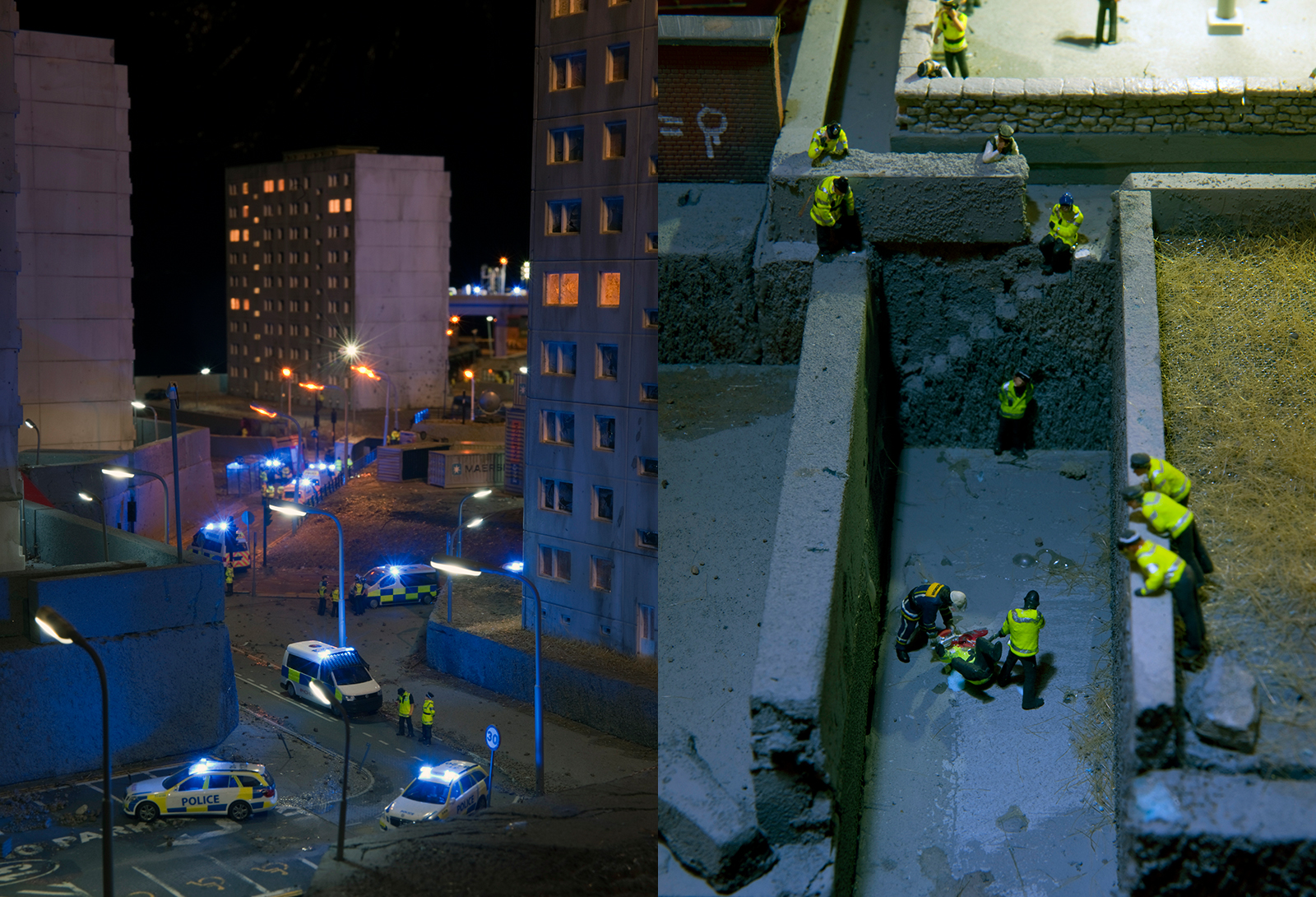



The concept of the tour evolved during the development of the work, reflecting the meanings inherent in both its form and content. When it was realised that the model was best viewed through peepholes, it became apparent that it should be enclosed. When it was clear that it would fit neatly inside a 40 ft shipping container, it became obvious that the work should travel ... but to where? Although not explicit, its relationship to A Riot in a Jam Jar suggests that the ADP’s ruined landscape is the result of some kind of mass riot:
… the proffered narrative telling us about an undefined upheaval, a riot with no articulated catalyst and an odd outcome. The only people left populating the dystopian ruin are the police – the rioters nowhere to be seen. In the absence of civilians to perform disobedience it falls to the constabulary. They paint graffiti, or scratch their heads.
Augustin Macellari, Crack Magazine, 10.03.2016
As such, the creative ‘logic’ for the tour demands that the ADP should go on a pilgrimage to riot sites around the country to explore this function of cause and effect, this narrative of bemusement – sites where a riot or significant civil unrest has occurred: places of real ‘Aftermath’, be it from more recent events or historic ones significant in the development of our socio-political and cultural landscape. In no way is the intention to explain the ADP concept or to romanticise the role of social disorder, but instead to tap into that stream of consciousness, whether radical or reactionary, pitting historical narratives against Cauty’s more chaotic, (and ironically) less contained creation.



-----------------------------------------------
OPENING NIGHT EVENT
10th October, 6pm-7.30,
Broad Street, City Centre, Stoke-on-Trent ST1 4HL (outside AirSpace Gallery)
6.15 - 6.45 - Speeches | A talk by historian Fred Hughes about the Pottery Riots of 1842 | A tour of the installation by artist Jimmy Cauty.
6.45 - 6.50 - “The People Are Not To Be Free” - a spoken word performance by Martin Gooding - A “call to arms” exploring the paralells between the politicisation of Britain in the 1840s and the increased politicisation in the youth as seen in recent years. Exploring how politicisation occurs and how youth apathy can rapidly become action. The piece will draw influence from the events of the Arab Spring, the rise of Jeremy Corbyn and the increase in importance of social media to the political system both in the UK and worldwide. The political actions particularly of those deemed to be of a lower class, bringing stories of Peterloo, The Chartists, The Diggers, The Punks and The Luddites into the context of Stoke on Trent in 2016.
6.50 - 7.30 - Songs for the Affected Generations - Local musician Ashley Wall will play a solo set of protest themed songs as a backdrop to the evening.
SET LIST
Bob Marley - Burnin’ and Lootin’
Pato Banton - Handsworth Riots
Richie Havens/Bob Dylan - Oxford Town
Rancid - I Wanna Riot
The Clash - White Riot
Kaiser Chiefs - I Predict A Riot
Sinead O’Connor - Downpresser Man
War - Why Can’t We Be Friends
Ashley Wall - Original Composition



Ashley Wall is a Staffordshire based musician, currently living in Stoke-On-Trent. You may recognise Ash from one of his local bands, originals group Captain Stingray’s Groove Machine or covers groups Le Beat and Last Orders. Playing live at least once a week Ash has honed his craft playing and running Open Mic Nights as well as performing more established, high end functions. His ability to quickly learn songs has lead to a great catalogue of music for his solo performances. A keen songwriter too, you may hear him slip some of his own work into sets.
Martin Gooding is a conceptual artist, creative producer and performer working and living in Stoke-On-Trent. Works often center on destruction, transformation, evolution or adaptation and sometimes take the form of shouting at things. His art is alive, whether that may take the form of performance works or inbuilt living elements such and mould, moss and lichen. He's inspired by great orators, trouble causers, hip hop and Shinsuke Nakamura.
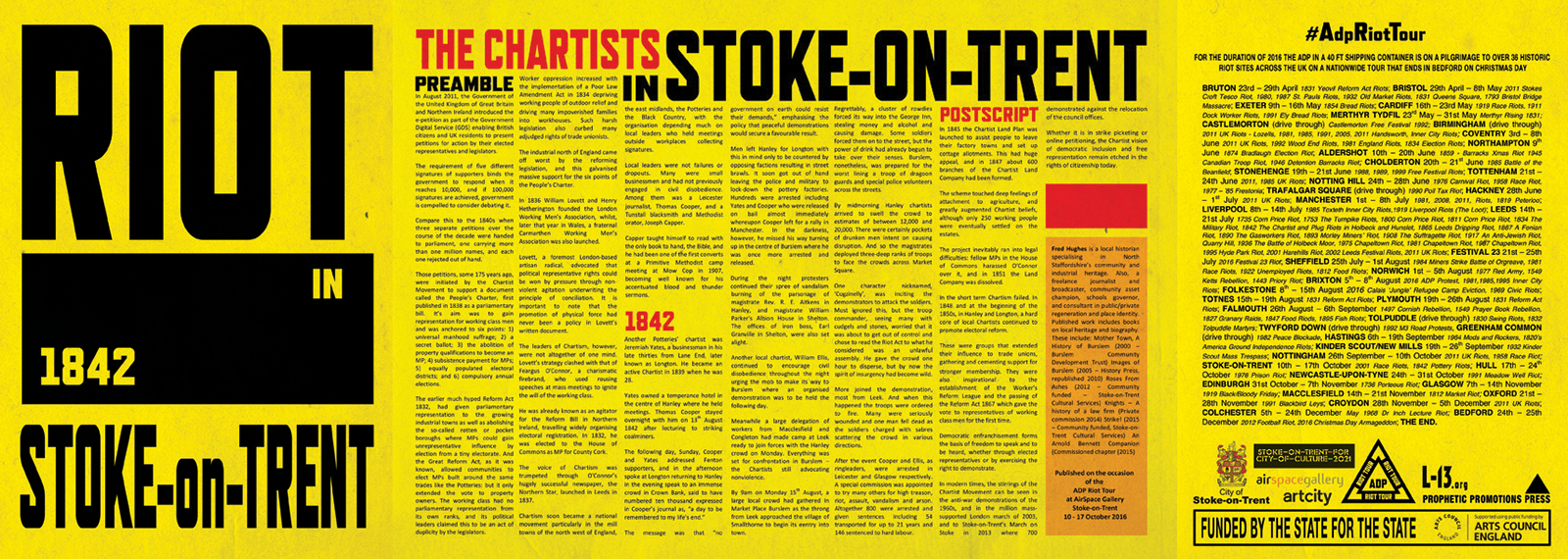
The Chartists In Stoke-on-Trent
a text by Fred Hughes
Preamble
In August 2011, the Government of the United Kingdom of Great Britain and Northern Ireland introduced the e-petition as part of the Government Digital Service (GDS) enabling British citizens and UK residents to present petitions for action by their elected representatives and legislators.
The requirement of five different signatures of supporters binds the government to respond when it reaches 10,000, and if 100,000 signatures are achieved, government is compelled to consider debating it.
Compare this to the 1840s when three separate petitions over the course of the decade were handed to parliament, one carrying more than one million names, and each one rejected out of hand.
Those petitions, some 175 years ago, were initiated by the Chartist Movement to support a document called the People’s Charter, first published in 1838 as a parliamentary bill. It’s aim was to gain representation for working class men and was anchored to six points: 1) universal manhood suffrage; 2) a secret ballot; 3) the abolition of property qualifications to become an MP; 4) subsistence payment for MPs; 5) equally populated electoral districts; and 6) compulsory annual elections.
The earlier much hyped Reform Act 1832, had given parliamentary representation to the growing industrial towns as well as abolishing the so-called rotten or pocket boroughs where MPs could gain unrepresentative influence by election from a tiny electorate. And the Great Reform Act, as it was known, allowed communities to elect MPs built around the same trades like the Potteries: but it only extended the vote to property owners. The working class had no parliamentary representation from its own ranks, and its political leaders claimed this to be an act of duplicity by the legislators.
Worker oppression increased with the implementation of a Poor Law Amendment Act in 1834 depriving working people of outdoor relief and driving many impoverished families into workhouses. Such harsh legislation also curbed many adjudged rights of trade unionists.
The industrial north of England came off worst by the reforming legislation, and this galvanised massive support for the six points of the People’s Charter.
In 1836 William Lovett and Henry Hetherington founded the London Working Men’s Association, whilst, later that year in Wales, a fraternal Carmarthen Working Men’s Association was also launched.
Lovett, a foremost London-based artisan radical, advocated that political representative rights could be won by pressure through non-violent agitation underwriting the principle of conciliation. It is important to note that the promotion of physical force had never been a policy in Lovett’s written document.
The leaders of Chartism, however, were not altogether of one mind. Lovett’s strategy clashed with that of Feargus O'Connor, a charismatic firebrand, who used rousing speeches at mass meetings to ignite the will of the working class.
He was already known as an agitator for the Reform Bill in Northern Ireland, travelling widely organising electoral registration. In 1832, he was elected to the House of Commons as MP for County Cork.
The voice of Chartism was trumpeted through O'Connor’s hugely successful newspaper, the Northern Star, launched in Leeds in 1837.
Chartism soon became a national movement particularly in the mill towns of the north west of England, the east midlands, the Potteries and the Black Country, with the organisation depending much on local leaders who held meetings outside workplaces collecting signatures.
Local leaders were not failures or dropouts. Many were small businessmen and had not previously engaged in civil disobedience. Among them was a Leicester journalist, Thomas Cooper, and a Tunstall blacksmith and Methodist orator, Joseph Capper.
Capper taught himself to read with the only book to hand, the Bible, and he had been one of the first converts at a Primitive Methodist camp meeting at Mow Cop in 1907, becoming well known for his accentuated blood and thunder sermons.
1842
Another Potteries’ chartist was Jeremiah Yates, a businessman in his late thirties from Lane End, later known as Longton. He became an active Chartist in 1839 when he was 28.
Yates owned a temperance hotel in the centre of Hanley where he held meetings. Thomas Cooper stayed overnight with him on 13th August 1842 after lecturing to striking coalminers.
The following day, Sunday, Cooper and Yates addressed Fenton supporters, and in the afternoon spoke at Longton returning to Hanley in the evening speak to an immense crowd in Crown Bank, said to have numbered ten thousand expressed in Cooper’s journal as, “a day to be remembered to my life's end.”
The message was that “no government on earth could resist their demands,” emphasising the policy that peaceful demonstrations would secure a favourable result.
Men left Hanley for Longton with this in mind only to be countered by opposing factions resulting in street brawls. It soon got out of hand leaving the police and military to lock-down the pottery factories. Hundreds were arrested including Yates and Cooper who were released on bail almost immediately whereupon Cooper left for a rally in Manchester. In the darkness, however, he missed his way turning up in the centre of Burslem where he was once more arrested and released.
During the night protesters continued their spree of vandalism burning of the parsonage of magistrate Rev. R. E. Aitkens in Hanley, and magistrate William Parker’s Albion House in Shelton. The offices of iron boss, Earl Granville in Shelton, were also set alight.
Another local chartist, William Ellis, continued to encourage civil disobedience throughout the night urging the mob to make its way to Burslem where an organised demonstration was to be held the following day.
Meanwhile a large delegation of workers from Macclesfield and Congleton had made camp at Leek ready to join forces with the Hanley crowd on Monday. Everything was set for confrontation in Burslem – the Chartists still advocating nonviolence.
By 9am on Monday 15th August, a large local crowd had gathered in Market Place Burslem as the throng from Leek approached the village of Smallthorne to begin its eentry into town.
Regrettably, a cluster of rowdies forced its way into the George Inn, stealing money and alcohol and causing damage. Some soldiers forced them on to the street, but the power of drink had already begun to take over their senses. Burslem, nonetheless, was prepared for the worst lining a troop of dragoon guards and special police volunteers across the streets.
By midmorning Hanley chartists arrived to swell the crowd to estimates of between 12,000 and 20,000. There were certainly pockets of drunken men intent on causing disruption. And so the magistrates deployed three-deep ranks of troops to face the crowds across Market Square.
One character nicknamed, ‘Cogzinelly’, was inciting the demonstrators to attack the soldiers. Most ignored this, but the troop commander, seeing many with cudgels and stones, worried that it was about to get out of control and chose to read the Riot Act to what he considered was an unlawful assembly. He gave the crowd one hour to disperse, but by now the spirit of insurgency had become wild.
More joined the demonstration, most from Leek. And when this happened the troops were ordered to fire. Many were seriously wounded and one man fell dead as the soldiers charged with sabres scattering the crowd in various directions.
After the event Cooper and Ellis, as ringleaders, were arrested in Leicester and Glasgow respectively. A special commission was appointed to try many others for high treason, riot, assault, vandalism and arson. Altogether 800 were arrested and given sentences including 54 transported for up to 21 years and 146 sentenced to hard labour.
Postscript
In 1845 the Chartist Land Plan was launched to assist people to leave their factory towns and set up cottage allotments. This had huge appeal, and in 1847 about 600 branches of the Chartist Land Company had been formed.
The scheme touched deep feelings of attachment to agriculture, and greatly augmented Chartist beliefs, although only 250 working people were eventually settled on the estates.
The project inevitably ran into legal difficulties: fellow MPs in the House of Commons harassed O’Connor over it, and in 1851 the Land Company was dissolved.
In the short term Chartism failed. In 1848 and at the beginning of the 1850s, in Hanley and Longton, a hard core of local Chartists continued to promote electoral reform.
These were groups that extended their influence to trade unions, gathering and cementing support for stronger membership. They were also inspirational to the establishment of the Worker’s Reform League and the passing of the Reform Act 1867 which gave the vote to representatives of working class men for the first time.
Democratic enfranchisement forms the basis of freedom to speak and to be heard, whether through elected representatives or by exercising the right to demonstrate.
In modern times, the stirrings of the Chartist Movement can be seen in the anti-war demonstrations of the 1960s, and in the million mass-supported London march of 2003, and to Stoke-on-Trent’s March on Stoke in 2013 where 700 demonstrated against the relocation of the council offices.
Whether it is in strike picketing or online petitioning, the Chartist vision of democratic inclusion and free representation remain etched in the rights of citizenship today.
Fred Hughes is a local historian specialising in North Staffordshire’s community and industrial heritage. Also, a freelance journalist and broadcaster, community asset champion, schools governor, and consultant in public/private regeneration and place identity. Published work includes books on local heritage and biography. These include: Mother Town, A History of Burslem (2000 – Burslem Community Development Trust) Images of Burslem (2005 – History Press, republished 2010) Roses From Ashes (2012 – Community funded – Stoke-on-Trent Cultural Services) Knights – A history of a law firm (Private commission 2014) Strike! (2015 – Community funded, Stoke-on-Trent Cultural Services) An Arnold Bennett Companion (Commissioned chapter (2015)
